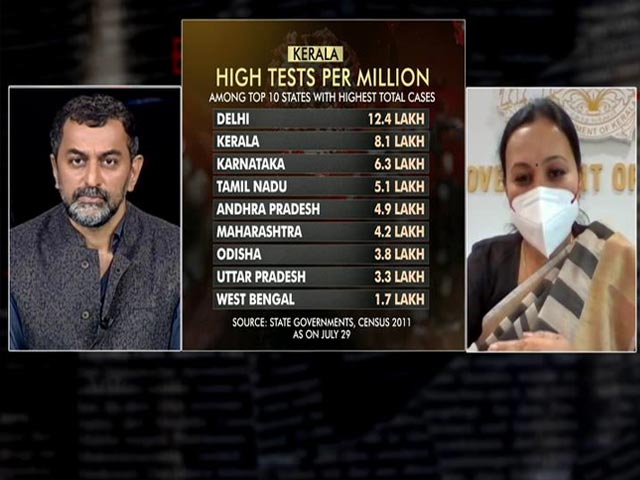New Delhi:
With more than 50 per cent of its population still not infected, the current Covid trend was always expected in the state, especially given its peculiar characteristics, Kerala Health Minister Veena George said on Friday. What is being seen now, she reiterated, was a result of a well-planned strategy to handle the pandemic.
Citing a number of parameters that indicate “our defensive measures were very good”, Ms George said the focus right now is on vaccines, something the state is running out of quickly.
“The situation in Kerala is absolutely under control. How do you anaylse this? Look at the data on occupancy in hospitals. It is less for hospitals, for ICU beds, and even in demand for oxygen support. It means the severity of the disease is less,” Ms George told NDTV in an exclusive interview.
“A Central team visited Kerala a couple of weeks ago. They visited many places, they visited hospitals, they went to many districts. They communicated to us that they are satisfied with the measures the government is adopting. They told us that plateau-formation in this phase is quite expected,” she said.
Ms George said several other experts and virologists, too, had reassured the Kerala administration about this “plateau formation”.
Kerala on Friday reported 20,772 new Covid cases, recording over 20,000 infections for the fourth straight day. Its test positivity rate (TPR) rose to 13.61 per cent. Up to 116 people died of the disease.
As of Thursday, July 29, some 50 per cent of India’s Covid cases were reported in Kerala. Up to 40 per cent of the country’s active cases were there. The average number of daily cases was up 50 per cent while it is down 6 per cent nationally.
Yet, Kerala’s fatality rate is a mere 0.4 per cent compared to the all-India average of 1.34 per cent. “Even if we add the excess deaths or all those deaths that went unreported, the state’s fatality rate will be somewhere around 0.8 per cent or 0.7 per cent,” the Health Minister said.
Kerala also has a far lower number of people exposed to the virus, according to Indian Council of Medical Research’s recent sero-survey which shows who has been infected based on antibodies present in people. The state’s figure was 44 per cent, the lowest in the country, while Madhya Pradesh had the highest (79 per cent).
At the same time, Kerala has one of the highest vaccination coverages at 17 per cent — India’s figure is 7 per cent.
“Two days ago, our vaccine stock was zero. The Central government then gave us nine lakh doses the day before yesterday. We will again run out of stocks tomorrow. There will be no vaccine for the day after tomorrow,” Ms George said, referring to the state’s performance on this front.
“Four days ago, we were able to vaccinate more than 4.9 lakh people on a single day,” she said.
Referring to the state’s unique problems, the minister said the Delta variant was causing the disease in the state in the second wave. In any case, she said, Kerala’s population density is almost double the national average. Add to that the high share of senior citizens – almost 14 per cent — she pointed out.
“We are making sure that every single case is identified and reported. Our strategy was to delay the peak. We have always tried to keep the number of cases below the medical capacity threshold (of the state),” she said.
“There is not a single case in Kerala where a patient has died without getting oxygen, medical support, a hospital bed, or ICU support. And we have proved that it is successful.”
Responding to criticism that Chief Minister Pinarayi Vijayan’s government had bungled by relaxing the Covid curbs for Bakrid a few days ago, she said it hadn’t made much difference.
“It was not about Bakrid…all our traders and sellers and shopkeepers were seeking relaxations,” she said. “At that time the TPR was almost 11 per cent. Even now it is almost 12-13 per cent. The government is closely monitoring the situation.”



Leave a Reply